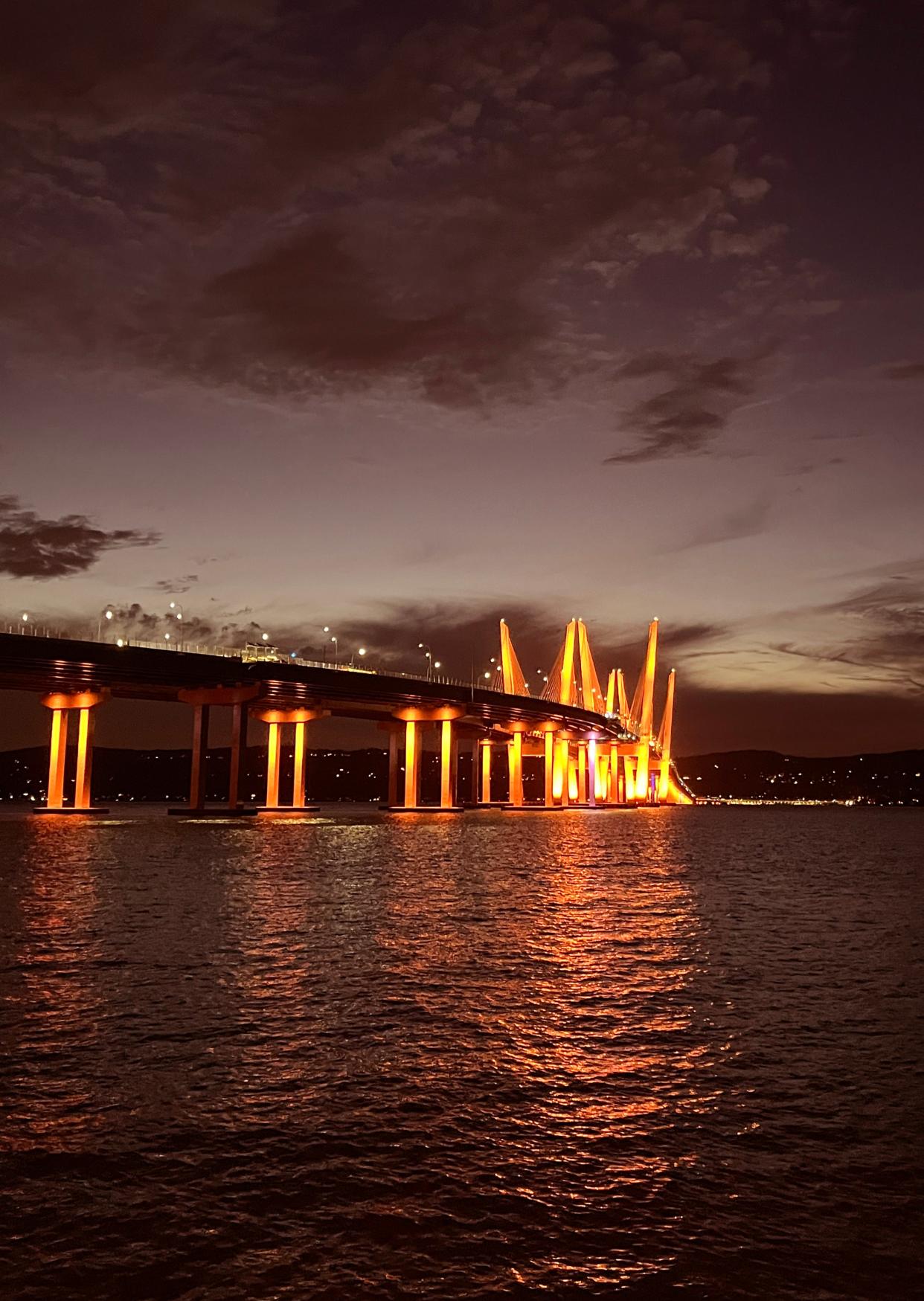Could a bridge collapse happen on the Hudson? Experts talk safety on Cuomo Bridge
The collapse of Baltimore’s Francis Scott Key Bridge after being struck by a massive cargo ship early Tuesday has ignited questions about the durability of the Mario M. Cuomo Bridge across the Hudson River.
The Dali, a 985-foot-long, Singapore-flagged ship bound for Sri Lanka, collided with a Key Bridge support column when it lost power soon after leaving the Port of Baltimore. Six construction workers on the bridge when it fell have not been found.
Could the Cuomo Bridge withstand such a hit?
“It’s not an abstract question,” said John Lipscomb, the boat captain and vice president of advocacy for Riverkeeper, the environmental watchdog group. “It’s a real question. The current Tappan Zee Bridge could take a hit. It will depend on the kind of vessel.”
Lipscomb regularly traverses the waters beneath the Cuomo Bridge in his 36-foot, wooden patrol boat, the R. Ian Fletcher.
We spoke to maritime experts as well as the bridge’s owners at the New York State Thruway Authority to gauge the likelihood of a collapse.

What measures are in place to prevent a collision?
The Cuomo Bridge opened to traffic in 2017, 40 years after the Key Bridge.
Its state-of-the-art columns are surrounded by fenders, small islands designed to absorb the impact of a collision and prevent ships from colliding with the bridge structure. They're sometimes described as pads or bumpers.
“If a barge with a blunt bow were to hit that fender system the fender system would probably have a better chance of stopping or deflecting the hit,” Lipscomb says.
But, Lipscomb notes, ships with large bows that extend beyond the portion of the vessel submerged in the water could pose a problem. “If a ship hits the fender island, how much of it is going to crush and collapse? I don’t know,” Lipscomb said. “It depends on the ship. It depends on the velocity, the load, the weight.”

Thruway Authority security personnel stationed at the bridge monitor operations around the clock, according to Jennifer Givner, a spokeswoman for the Thruway Authority. They will alert the U.S. Coast Guard if any issues arise.
And security cameras monitor the navigation channel beneath the bridge.
Power: Riverkeeper fears underwater Hudson cables will be 'an extension cord to New York City'
Are there height limits for ships on the Hudson?
The Cuomo Bridge’s vertical clearance is 139 feet at low tide and the width of the navigation channel is 600 feet. The required clearance between the top of a ship and the bottom of the bridge is two feet.
The Hudson River Pilots Association, which assists ships navigating the river, says ships need to have a vertical clearance of around 134 feet to traverse the river's bridges.
The Key Bridge was 185 feet tall, allowing for larger vessels heading in and out of the Port of Baltimore. And the water depth below is around 50 feet.
The depth beneath the Cuomo Bridge is around 30 feet. Heavier ships that create a deeper draft — the distance between the water line and the bottom of the boat — would run the risk of running aground.
“Mostly tugs and barges,” is how one veteran tugboat operator describes Hudson River traffic.
The dimensions at the Key Bridge more closely mirror those at the Verrazzano Bridge in the Narrows, which, at 228 feet above the water, allows large cruise and cargo ships to course underneath.
Barges: How a Coast Guard move could allow barges to anchor in the Hudson River after all
Have there been boating mishaps on the Hudson?
There sure have.
In 2017, a tanker carrying 2.5 million gallons of gasoline ran aground near Catskill, 30 miles south of Albany, during foggy conditions. Nothing spilled.
Five years before, a 600-foot-long tanker carrying 12 million gallons of crude oil ran aground 14 miles north of Catskill in Stuyvesant.
The outer layer of the Swedish-owned Stena Primorsk’s hull was pierced but oil did not pollute the river. Published reports indicated the tanker lost power.
Both incidents raised concerns among advocates and lawmakers fearful that as more tankers carrying oil and gas make their way up and down the river, a spill is likely.
Lawsuit: Thruway official rejects almost all of Cuomo Bridge builder's $960M in claims
How about at the Cuomo Bridge?
During construction on the new bridge in 2016, a crane collapsed on the deck of the old bridge, causing drivers to slam on their brakes.
Federal investigators determined a plate on the clamp for a vibratory hammer used to drive piles into the Hudson was damaged. And as the crane operator was raising the boom, the hammer released, causing the crane to break apart.
Bridge: Will dispute over Cuomo Bridge construction up the cost of the bridge?
In 2013, two people were killed when a speedboat slammed into a steel barge being used for the construction of the new bridge. The driver of the speedboat pleaded guilty in 2014 to charges that he was drunk when he crashed into the barge.
This article originally appeared on Rockland/Westchester Journal News: Baltimore Key bridge collapse: Could Cuomo Bridge withstand collision?
